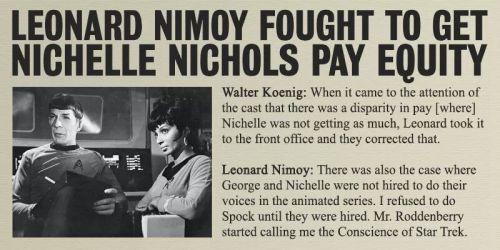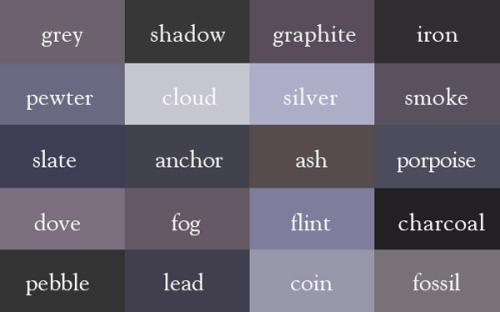It’s Important To Remember Star Trek Was More Than Just A Science-fiction Show.
It’s important to remember Star Trek was more than just a science-fiction show.

Wow I never knew this
More Posts from Athenadonovan and Others

Interesting
Symbols of the Galaxy
When the Andor title and sizzle reel were released, we also saw a brand new symbol from the GFFA. It makes up the O in the Andor title.

Here are some Rebel Alliance-affiliated symbols for comparison.

From left to right: a rebel symbol seen on the helmets of some pilots in Rogue One; the traditional symbol for the Alliance to Restore the Republic aka the Rebel Alliance as first seen in A New Hope; and the symbol for the Alliance, particularly Phoenix Cell, as first seen in Star Wars: Rebels. These symbols have been generally referred to as a variation on a starbird.
The following are some other symbols seen in the GFFA for comparison.

From left to right: the symbol for the Confederacy of Independent Systems, aka the Separatists; the symbol for the Jedi Order; the symbol for the Galactic Republic; and the symbol for the Empire.
The Andor symbol is most similar to rebel symbols from the Rebellion era than any symbols from the Prequels era, including the Separatists with whom Cassian was once affiliated.
So, it’s likely that the symbol we see in Andor is that of an early rebel group, like Pheonix Cell.
Potentially, this could be the symbol for the Atrivis Resistance Group, or a predecessor. The ARG does not yet have a symbol in canon, nor did it have one in Legends based on available information.
Loved her. 😢








Dame Enid Diana Elizabeth Rigg.
20.6.1938 - 10.9.2020. Legend. RIP.
Reblogging because this is brilliant.
Color Synonyms
White

also: pale; blanched; sallow; pallid; waxen; spectral; translucent; albino;
Grey

also: dust; stone; pepper;
Black

also: coal; slate; dusky; ebon; shadow; murky;
Tan

also: flesh; khaki; cream; tawny;
Brown

also: henna; russet; sepia; chestnut; cocoa; drab; bronze;
Red

also: terracotta ; rouge; carmine; fire-engine; ruddy
Orange

also: pumpkin ; rust ;
Yellow

also: sunny; amber; saffron; hay; straw; platinum;
Green

also: viridescent; grass; jade; forest;
Blue

also: turquoise; cyan; ultramarine; royal; aqua; aquamarine;
Purple

also: berry; amaranthine;
Pink

also: flushed; candy; cherry blossom; petal pink ;
—– source: http://ingridsundberg.com/
—–additional synonyms added by me

Here’s another photo of De (looking awesome in his coat, vest and tie) during the Star Trek production team’s visit to a NASA facility in 1967.
The photos below have been posted before by me and others (check out @star trek nasa visit), but I like to have them all together in one post, so there you go.





Abrams does not have he best track record with movies in my book, but these characters are delightful.

@jjabrams It feels impossible, but today wrapped photography on Episode IX. There is no adequate way to thank this truly magical crew and cast. I’m forever indebted to you all.

Mike Minor
Love this!

Yes! Love the thought out behind space travel here.
Thought on science fictional hyperspaces:
So, like a lot of science fiction writers, in a couple of my science fiction settings I explain “fast” interstellar communication and travel by saying it involves sending messages and spacecraft through “hyperspace.” Hyperspace is a sort of “basement” of our universe that messages and ships can pass through; it is more compact than our space, and there is a correspondence between locations in hyperspace and locations in our space. So, a ship can enter hyperspace, travel a few hundred or thousand AU or a light year or something, go back to our space, and be in the Alpha Centauri system. This is possible because hyperspace offers a possible path where e.g. the distance between our solar system and Alpha Centauri is less than 4 light years; hyperspace is a cosmic short-cut. You can send radio messages through the same short-cut, if you stick the right parts of the transmitter and receiver into hyperspace.
So far, so I good, but like a lot of science fiction writers I also prefer to limit hyperspace travel so it’s more-or-less useless for relatively short journeys, e.g. between planets of our solar system within the orbit of Uranus. This is mostly because I like that hard SF stuff where space travel within a solar system is treated relatively realistically and a solar system still feels big. I’m OK with hyperspace for letting my characters get to Tau Ceti in less than twelve years, but when it comes to asteroid mining, space battles, etc., I want that stuff to work more-or-less like it would in real life. Larry Niven had a nice approach for this: just say you can’t enter or exit hyperspace close to a large mass, so e.g. you can’t enter or exit hyperspace within 20 AU of our sun. To travel to Alpha Centauri through hyperspace you have to travel out beyond Sol’s hyper-limit, then go into hyperspace and take the hyperspace short-cut, then exit hyperspace outside Alpha Centauri’s hyper-limit, then travel the rest of the way in our space. A hyper-limit limitation on hyperspace travel works well for me. I’m less satisfied with it as a limitation on hyperspace communication though, and a few days ago I had an idea for that which I like.
It came to me as I was thinking about how hyperspace travel is kind of analogous to being able to travel through the interior of a sphere instead of being limited to travelling on its outer surface. If you have a sphere the size of Earth and you want to get to a point on the exact opposite side of it, if you have to travel along the outer circumference that’s a journey of 40,000 kilometers, but if you could travel in a straight line through the center of the sphere that’s only 12,750 kilometers. Travelling from Sol to Alpha Centauri in our space is analogous to being limited to travelling along the outer circumference of a sphere, making the same journey through hyperspace is analogous to taking a short-cut through the interior of the sphere.
And it occurred to me to mentally pull on one feature of this analogy: a short-cut through the interior of a sphere would be much more useful for long journeys than for short ones. Again, let’s say the sphere is the size of Earth. If you only want to travel one meter, the difference between a path along the outer circumference of the sphere and a short-cut through its interior is very small. A 1 meter path along flat ground is pretty close to being a straight line. On the other hand, if you want to get to the other side of the sphere, the path along the sphere’s outer circumference is more than three times as long as the path through the center of the sphere.
And I had the idea: what if hyperspace works in a way that’s analogous to that? Maybe the distance between, say, Earth and Jupiter is analogous to a 1 meter distance on the surface of the Earth; so small that the shortest possible path through hyperspace is almost as long as the shortest possible path through our space. Then the distance to Alpha Centauri might be more analogous to a journey across a large fraction of Earth’s circumference; it’s big enough that the shortest possible path through our space is orders of magnitude longer than the shortest possible path through hyperspace. The geometry involved is probably a lot less straightforward than spherical geometry to humans, so for short distances the relationship between our space distances and hyperspace distances might even invert; you might have a set-up where 100 light years in our space is 5 light years in hyperspace, 4 light years in our space is 1 light year in hyperspace, and 1 AU in our space is 4 AU in hyperspace.
This might get you a set-up where you can have relatively fast interstellar communication and travel, but within the orbit of Neptune (or equivalent distance) you’re stuck dealing with light lag.
It would also have the interesting effect that hyperspace travel gets faster for longer journeys. A 1 year voyage might take you to Alpha Centauri, a 5 year voyage might take you 100 light years, a 20 year voyage might take you to the other side of the galaxy, a 100 year voyage might take you to a distant galaxy billions of light years away.
Just this.








-
 scribblermerlin liked this · 2 months ago
scribblermerlin liked this · 2 months ago -
 mr-snakey-wakey liked this · 3 months ago
mr-snakey-wakey liked this · 3 months ago -
 balalaijka liked this · 3 months ago
balalaijka liked this · 3 months ago -
 the-aliens-believe-in-you-too reblogged this · 3 months ago
the-aliens-believe-in-you-too reblogged this · 3 months ago -
 the-aliens-believe-in-you-too liked this · 3 months ago
the-aliens-believe-in-you-too liked this · 3 months ago -
 gizromana liked this · 3 months ago
gizromana liked this · 3 months ago -
 kabra-malvada liked this · 3 months ago
kabra-malvada liked this · 3 months ago -
 ostrichrider reblogged this · 3 months ago
ostrichrider reblogged this · 3 months ago -
 ostrichrider liked this · 3 months ago
ostrichrider liked this · 3 months ago -
 shortness-of-bitch reblogged this · 3 months ago
shortness-of-bitch reblogged this · 3 months ago -
 shortness-of-bitch liked this · 3 months ago
shortness-of-bitch liked this · 3 months ago -
 usoppsleftnostril liked this · 5 months ago
usoppsleftnostril liked this · 5 months ago -
 roxas-von-einzbern reblogged this · 5 months ago
roxas-von-einzbern reblogged this · 5 months ago -
 kobaiaxii liked this · 7 months ago
kobaiaxii liked this · 7 months ago -
 tbonner2 liked this · 7 months ago
tbonner2 liked this · 7 months ago -
 thecolorofthegame liked this · 7 months ago
thecolorofthegame liked this · 7 months ago -
 komodomagic reblogged this · 7 months ago
komodomagic reblogged this · 7 months ago -
 komodomagic liked this · 7 months ago
komodomagic liked this · 7 months ago -
 oliverqueenlance reblogged this · 7 months ago
oliverqueenlance reblogged this · 7 months ago -
 mechaghostgirl reblogged this · 7 months ago
mechaghostgirl reblogged this · 7 months ago -
 the-glass-hammer reblogged this · 7 months ago
the-glass-hammer reblogged this · 7 months ago -
 theydoctor liked this · 7 months ago
theydoctor liked this · 7 months ago -
 crigby liked this · 7 months ago
crigby liked this · 7 months ago -
 fvckingcrazybutfree liked this · 7 months ago
fvckingcrazybutfree liked this · 7 months ago -
 strunmahalok liked this · 7 months ago
strunmahalok liked this · 7 months ago -
 moonlight19256 reblogged this · 7 months ago
moonlight19256 reblogged this · 7 months ago -
 moonlight19256 liked this · 7 months ago
moonlight19256 liked this · 7 months ago -
 garbageboy-stinkman liked this · 7 months ago
garbageboy-stinkman liked this · 7 months ago -
 theflashjaygarrick reblogged this · 7 months ago
theflashjaygarrick reblogged this · 7 months ago -
 theflashjaygarrick liked this · 7 months ago
theflashjaygarrick liked this · 7 months ago -
 zagreuses-toast reblogged this · 7 months ago
zagreuses-toast reblogged this · 7 months ago -
 zagreuses-toast liked this · 7 months ago
zagreuses-toast liked this · 7 months ago -
 kitty-dw28 reblogged this · 8 months ago
kitty-dw28 reblogged this · 8 months ago -
 breadmakerjoy liked this · 8 months ago
breadmakerjoy liked this · 8 months ago -
 warmhugs4pugs reblogged this · 8 months ago
warmhugs4pugs reblogged this · 8 months ago -
 warmhugs4pugs liked this · 8 months ago
warmhugs4pugs liked this · 8 months ago -
 ebeneezerboob liked this · 8 months ago
ebeneezerboob liked this · 8 months ago -
 the-thing-named-shallot liked this · 10 months ago
the-thing-named-shallot liked this · 10 months ago -
 sadpterodactyl liked this · 10 months ago
sadpterodactyl liked this · 10 months ago -
 waystarresourceco liked this · 10 months ago
waystarresourceco liked this · 10 months ago -
 sudokuishere liked this · 10 months ago
sudokuishere liked this · 10 months ago -
 mischief-night-ghost liked this · 10 months ago
mischief-night-ghost liked this · 10 months ago -
 blackhxartink reblogged this · 10 months ago
blackhxartink reblogged this · 10 months ago -
 blackhxartink liked this · 10 months ago
blackhxartink liked this · 10 months ago -
 sseanettles reblogged this · 11 months ago
sseanettles reblogged this · 11 months ago -
 radiofuckingaga reblogged this · 1 year ago
radiofuckingaga reblogged this · 1 year ago -
 radiofuckingaga liked this · 1 year ago
radiofuckingaga liked this · 1 year ago -
 deeneedsaname reblogged this · 1 year ago
deeneedsaname reblogged this · 1 year ago -
 shahofthelands liked this · 1 year ago
shahofthelands liked this · 1 year ago
